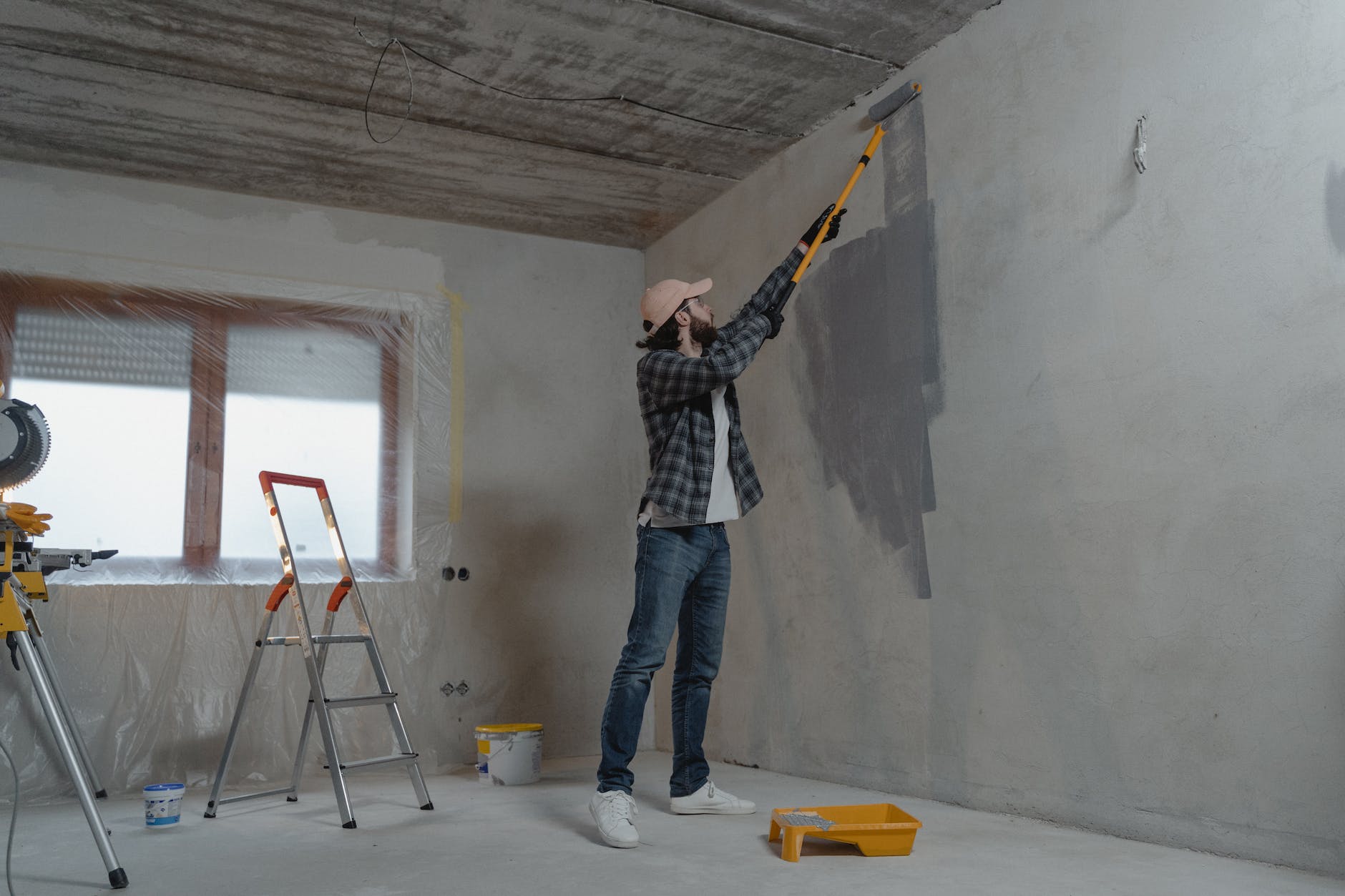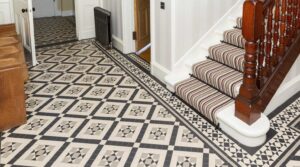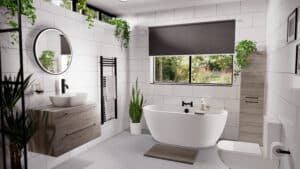Embracing the DIY Spirit
The journey of mastering DIY skills for bathroom renovation projects is both challenging and rewarding. It begins with understanding the advantages and potential pitfalls of doing your own bathroom renovations.
The Benefits of DIY Bathroom Renovations
Doing your own bathroom renovations has numerous benefits. First, it can save you a significant amount of money. By taking on the labor yourself, you eliminate the cost of hiring professionals. This can be especially beneficial for those working on a tight budget. For more on this, read our article on cost-effective bathroom renovations: tips for budget planning.
Another advantage of DIY renovations is the sense of accomplishment and satisfaction that comes with completing a project using your own skills and hard work. Whether you’re updating a small powder room or tackling a large master bathroom, seeing the transformation can be incredibly rewarding.
Taking the DIY approach also allows you to work at your own pace and make decisions that best suit your personal preferences and needs. Whether it’s choosing the perfect color scheme or selecting eco-friendly materials, you have the final say on all aspects of the project. Check out our article on choosing the right materials for your bathroom renovation for helpful tips.
Challenges and Common Mistakes in DIY Bathroom Renovations
While DIY bathroom renovations can be beneficial, they also come with certain challenges. One of the main obstacles DIYers face is a lack of expertise in certain areas, such as plumbing or electrical work. This can lead to mistakes that may require costly repairs.
Time management can also be a challenge. Bathroom renovations can be time-consuming, and if you’re balancing the project with other responsibilities, it can be difficult to stay on schedule.
Another common mistake is not planning adequately for unexpected issues. During renovations, you may uncover hidden problems such as water damage or outdated wiring. If you haven’t factored these possibilities into your timeline and budget, they can cause significant setbacks.
To help you navigate these challenges, we’ve compiled a list of common mistakes and how to avoid them in our article expert advice: common bathroom renovation mistakes to avoid.
Despite these challenges, with careful planning, a willingness to learn, and a bit of patience, you can successfully complete a DIY bathroom renovation. As you continue in your DIY journey, remember to embrace both the triumphs and the obstacles as opportunities for growth and learning.
Essential Skills for Bathroom Renovations
Taking on a DIY bathroom renovation requires a wide range of skills. From plumbing to painting, understanding these fundamentals will not only help ensure a successful project but also increase safety and efficiency.
Plumbing Basics
One of the key skills in bathroom renovations is understanding basic plumbing. This includes knowledge about different types of pipes, how to install and replace fixtures, and how to troubleshoot common issues like leaks or blockages. Basic plumbing skills can help one save money and avoid potential water damage during a renovation.
It’s also important to understand the local plumbing codes and regulations. This will ensure the safety and functionality of your bathroom while complying with local regulations. Some typical plumbing tasks in a bathroom renovation might include installing a new sink, replacing a showerhead, or updating the toilet. For more detailed insights, our step-by-step guide for homeowners can be a useful reference.
Electrical Work Fundamentals
Having a basic understanding of electrical work is another crucial skill for bathroom renovations. This might include knowing how to safely replace light fixtures, install exhaust fans, or add additional outlets. Remember, safety is paramount when dealing with electricity. Always switch off the power at the breaker box before beginning any electrical work.
Additionally, understanding the local electrical codes and regulations is essential. Electrical work in wet areas like bathrooms requires special considerations to prevent accidents. For complex electrical tasks, it’s advisable to hire a licensed electrician.
Tiling and Grouting Skills
Tiling is another key skill for bathroom renovations. This involves knowing how to properly lay and adhere tiles, how to cut tiles to fit around fixtures or corners, and how to grout and seal the tiles.
A well-tiled bathroom can add beauty and value to your home. But tiling requires precision and patience. Inaccurate cuts or misaligned tiles can be visually distracting and may lead to water damage. Proper grouting and sealing are also crucial to prevent water penetration and mold growth.
Painting and Finishing Techniques
Finally, painting and finishing techniques are essential skills for bathroom renovations. This involves preparing the surface, applying primer, and painting with the right type of paint. Remember, bathrooms require specially-formulated paints that resist moisture and prevent mold and mildew.
Also, knowing how to apply finishes like caulking around the sink, bathtub, or shower can create a professional-looking result and prevent water leaks.
By mastering these basic skills, DIY enthusiasts can tackle bathroom renovation projects with confidence. However, it’s important to remember that some tasks may require professional help. Always assess your skills realistically and seek professional help when necessary. For more tips on bathroom renovations, have a look at our expert advice on common renovation mistakes to avoid.
Project Planning for Bathroom Renovations
A well-planned project is the first step towards a successful DIY bathroom renovation. This involves clearly outlining your renovation goals, establishing a practical timeline, and meticulously budgeting for the renovation.
Outlining Your Renovation Goals
First and foremost, define the objectives and scope of your bathroom renovation project. Are you aiming for a complete overhaul or just looking to update certain elements? Do you want to incorporate luxurious features or stick to a minimalist design? Perhaps you’re interested in modernizing your bathroom with the latest trends, as discussed in our article on modernizing your space: top bathroom renovation trends of 2024. Alternatively, you may be interested in eco-friendly solutions as outlined in our post on eco-friendly bathroom renovations: sustainable design tips.
Having clear goals helps to guide your project, from choosing the right materials to deciding on the style and layout. It’s crucial to keep these goals realistic and aligned with your budget and time constraints to ensure a smooth renovation process.
Creating a Practical Timeline
Once you’ve outlined your goals, it’s time to create a timeline for your bathroom renovation. This should include all stages of the project, from the initial planning and design to the final touches. Be sure to allow sufficient time for each task, and factor in potential delays, such as shipping times for materials or unexpected construction challenges.
A well-structured timeline not only helps to keep your project on track but also allows you to manage your time effectively. For a step-by-step guide on bathroom renovation timelines, check out our article on bathroom renovations: a step-by-step guide for homeowners.
Budgeting for Your Bathroom Renovation
Budgeting is a critical aspect of any renovation project. It’s important to have a clear understanding of the costs involved, from materials and labor to unexpected expenses that may arise. Always factor in a contingency budget for unforeseen costs.
Start by making a list of all the materials and services you’ll need and research their prices. Don’t forget to include the cost of tools, equipment, and safety gear if you don’t already have them.
For more advice on planning a cost-effective bathroom renovation, see our article on cost-effective bathroom renovations: tips for budget planning.
With clear goals, a realistic timeline, and a carefully planned budget, you’ll be well-prepared to start your bathroom renovation project. Remember, successful DIY projects are not just about mastering the technical skills but also about effective planning and management.
Safety Considerations for Bathroom DIY Projects
When embarking on DIY bathroom renovation projects, understanding safety considerations is paramount. From respecting building codes to using tools safely and knowing when to enlist professional help, these elements are crucial to a successful and secure renovation.
Understanding and Respecting Building Codes
Building codes are designed to ensure safety and quality in construction and renovation projects. They set the standards for construction methods, materials, and designs. When it comes to bathroom renovations, it’s imperative to familiarize oneself with local building codes. These codes often cover aspects such as plumbing and electrical work, ventilation, and waterproofing.
Violating building codes can lead to fines, and in some cases, may require homeowners to undo the completed work. Therefore, it’s essential to obtain necessary permits and inspections when required. For more information on common mistakes to avoid during bathroom renovations, you can check out our article on expert advice: common bathroom renovation mistakes to avoid.
Safe Use of Tools and Equipment
The safe use of tools and equipment is critical in all DIY projects, including bathroom renovations. From power tools to hand tools, each piece of equipment carries potential risks if not handled correctly. For example, saws and drills can cause injuries if used improperly, and even simple tools like hammers and screwdrivers can cause damage if not used with care.
Before starting the renovation, ensure you have a clear understanding of how to use each tool. Always follow the manufacturer’s instructions and safety guidelines. Wear appropriate protective gear, such as gloves, safety glasses, and sturdy footwear to protect against potential hazards.
When to Call in the Professionals
While the DIY approach can be rewarding and cost-effective, there are times when it’s best to call in professionals. Tasks involving plumbing, electrical work, or structural changes often require specialized skills and knowledge. Attempting these tasks without the necessary expertise can lead to costly mistakes or even dangerous situations.
If a project seems beyond your skill level, don’t hesitate to hire a professional. While it may increase the cost of your renovation, it can ensure the job is done safely and correctly. For further guidance on planning and budgeting your bathroom renovation, you can refer to our cost-effective bathroom renovations: tips for budget planning article.
In conclusion, safety should always be a top priority in any DIY project. By understanding and respecting building codes, using tools and equipment safely, and knowing when to call in professionals, you can ensure your bathroom renovation project is not only successful, but also safe.
Mastering DIY: Enhancing Your Renovation Skills
Mastering the art of do-it-yourself, particularly in bathroom renovations, involves a continuous cycle of learning, practicing, and connecting with other DIY enthusiasts. Here are some ways to enhance your renovation skills.
Learning Resources for DIY Enthusiasts
There are numerous resources available for those keen on improving their DIY skills. These range from online tutorials, home improvement blogs, instructional books, and even classes at local community centers. Make it a point to stay updated with the latest techniques, materials, and trends in bathroom renovations.
For instance, our step-by-step guide on bathroom renovations provides a comprehensive walkthrough of the renovation process. Likewise, if you’re interested in current trends, our article on top bathroom renovation trends of 2024 can provide valuable insights.
Practice Makes Perfect: Gaining Experience
The key to mastering any skill, including DIY bathroom renovations, is consistent practice. Start with small-scale projects before progressing to larger and more complex renovations.
Begin by familiarizing yourself with basic tasks such as painting or replacing fixtures. Document your progress and learn from any mistakes or challenges you encounter. You can find inspiration and practical tips from our collection of before and after renovation stories.
Networking with Other DIY Enthusiasts
Joining a community of DIY enthusiasts can provide a wealth of knowledge and support. Online forums, social media groups, and local clubs are excellent platforms for sharing experiences, tips, and advice.
Engaging with other DIY enthusiasts can also provide opportunities to collaborate on projects, exchange ideas, and learn from others’ experiences. You might even find solutions to challenges you’ve encountered in your own renovation projects.
In conclusion, mastering DIY involves a combination of learning, practicing, and networking. Armed with the right knowledge, hands-on experience, and a supportive community, you can successfully undertake and complete your bathroom renovation projects.




